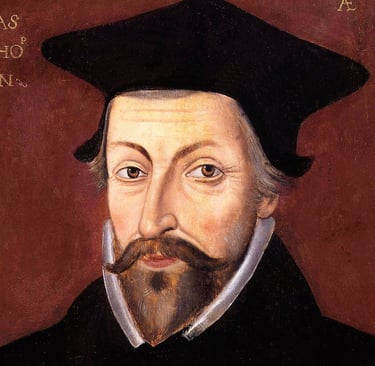Bishop Nicholas Ridley: The Rochester Martyr Who Defied Queen Mary I
Rochester’s history is steeped in tales of courage, conviction, and—sometimes—tragic sacrifice. One of the most harrowing stories belongs to Bishop Nicholas Ridley, a man of unshakable faith who stood against the tide of religious change in Tudor England. His unwavering opposition to Queen Mary I’s mission to restore Roman Catholicism ultimately led to his horrifying execution, a fate so grim that it stands out as one of the darkest moments in England’s history of religious persecution.


Bishop of Rochester: A Brief Tenure in a Turbulent Time
Born around 1500, Nicholas Ridley was a brilliant scholar, a key figure in the English Reformation, and a committed Protestant reformer. He became Bishop of London, but in 1547, under the Protestant rule of King Edward VI, he was also appointed Bishop of Rochester. His time in Rochester was short-lived—just three years—but it placed him in the heart of the religious upheaval gripping England.
As one of the architects of England’s break from Rome, Ridley supported the Protestant cause with a fervour that would prove fatal when Mary I, the devoutly Catholic daughter of Henry VIII, ascended the throne in 1553. She immediately began reversing Protestant reforms, restoring papal authority, and persecuting those who stood in her way. Ridley, unrepentant in his beliefs, was a prime target.
The Wrath of ‘Bloody Mary’
Unlike many who chose exile or silence in the face of Mary’s harsh regime, Ridley refused to back down. He publicly denounced the Queen’s efforts to reinstate Catholicism, branding her rule a betrayal of England’s spiritual future. For his defiance, he was arrested, imprisoned, and put on trial for heresy.
He was condemned alongside Hugh Latimer, another Protestant bishop, and together they were sentenced to death. Their fate? To be burned at the stake in Oxford on 16 October 1555—one of the most gruesome methods of execution known in history.
The Longest Agony in English Burning History
Ridley’s death was not just brutal—it was exceptional in its suffering. Thanks to John Foxe, a Protestant exile in what is now Belgium, we have a detailed account of the horror that unfolded that day.
While many victims of execution by fire succumbed relatively quickly, Ridley took an unimaginable nine hours to die—the longest known time of any burning at the stake in England’s recorded history. The flames, instead of engulfing him swiftly, burned unevenly, causing prolonged, excruciating agony. His suffering dragged on for hours, and it was only ended when his brother-in-law’s men poured an accelerant onto the pyre, hastening the inevitable.
Ridley’s Legacy: Martyrdom and Memory
Ridley’s death was a defining moment in England’s religious history. He became one of the most famous Protestant martyrs, symbolising the brutal cost of defying Mary I’s Catholic restoration. His execution, alongside Latimer’s, is commemorated at Oxford’s Martyrs’ Memorial, where his courage and sacrifice are still honoured today.
For those fascinated by Ridley’s tragic end, the Original Rochester Spooky Tour, one of the most popular ghost walks in Kent, delves into the full account of his story. Running from October to the end of February, this eerie tour unveils the chilling history of Rochester, bringing Ridley’s harrowing fate—and other dark tales of the past—to life.
Rochester has no shortage of haunted history, but few stories are as gut-wrenching as that of Bishop Nicholas Ridley. His stand against ‘Bloody Mary’ cost him his life, but it secured his place in history as a man who refused to be silenced, no matter the cost.

